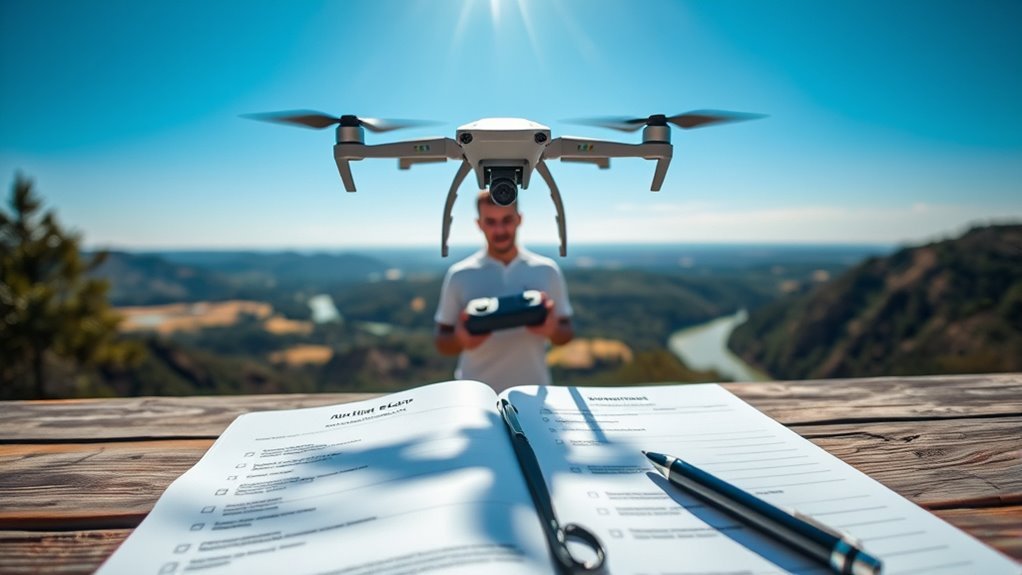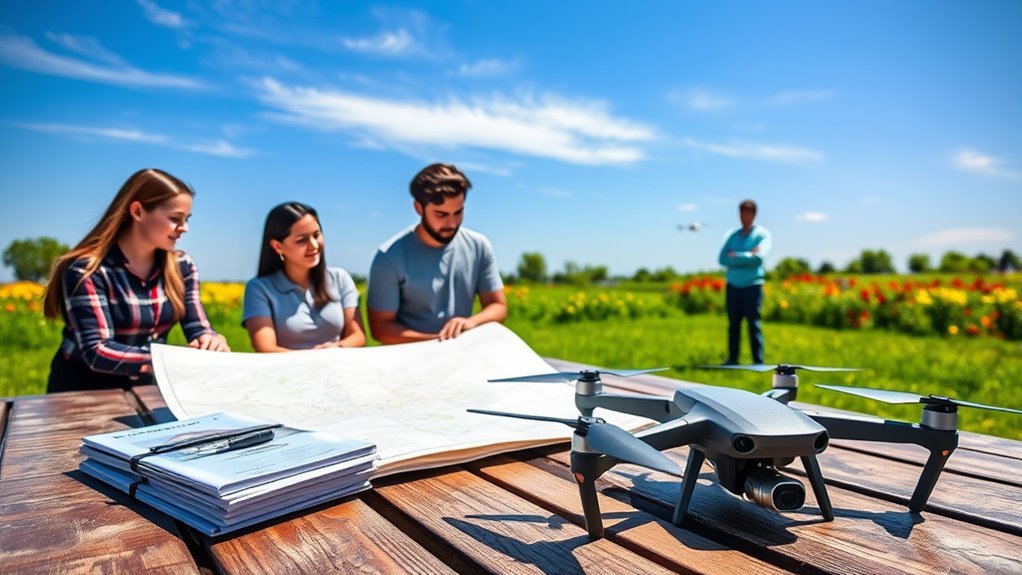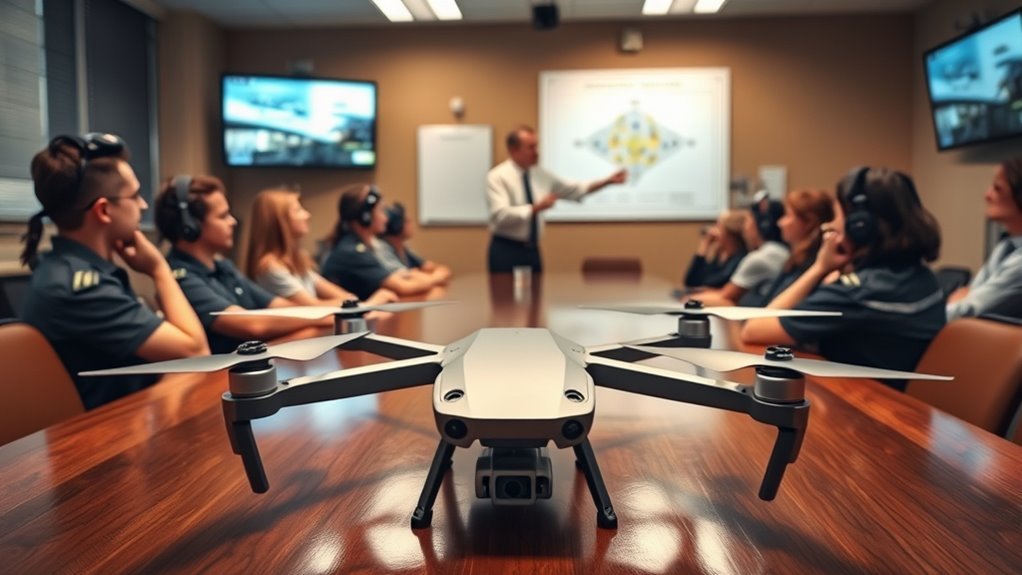To become a certified drone pilot, you need to understand FAA regulations, register your drone, and choose the right model for your needs. Enrolling in ground school is essential for mastering flight rules and safety protocols. Prepare for the Part 107 exam by utilizing study materials and practice tests. Maintain your certification with regular educational updates. Building a portfolio and networking can lead to job opportunities. Keep going to discover more about enhancing your skills and expanding your possibilities.
Understanding the FAA Regulations

When you’re preparing to fly a drone commercially, understanding the FAA regulations is essential, as compliance guarantees both safety and legality. First, familiarize yourself with the FAA guidelines, which outline operational limits, airspace restrictions, and pilot certification requirements. You’ll need to register your drone, ensuring it meets the weight criteria and is clearly marked with its registration number. This process not only legitimizes your equipment but also helps in maintaining accountability. Remember, flying without proper registration can lead to hefty fines and legal troubles. By adhering to these regulations, you’re not just protecting yourself; you’re contributing to the broader safety of the skies, allowing you the freedom to explore and capture stunning aerial imagery legally and responsibly.
Choosing the Right Drone for Certification

Choosing the right drone for certification can considerably impact your success as a commercial pilot. You’ll want to evaluate essential drone features like camera quality, battery life, and payload capacity, as these will determine your operational capabilities. Consider what specific tasks you plan to undertake, whether it’s aerial photography or surveying. Moreover, selecting a drone with autonomous spraying capabilities can enhance your efficiency in agricultural applications.
Budget considerations are significant; high-end models offer advanced features but can break the bank. Balance your needs against your financial limits to find a drone that meets both your operational requirements and your budget. Researching various models and reading reviews can help you make an informed decision. Ultimately, choosing wisely can enhance your skills and expand your freedom as a certified drone pilot. Additionally, ensure that the drone you select includes safety features like collision avoidance and GPS stabilization, which are crucial for secure flying experiences.
The Importance of Ground School

Ground school is vital for you as a certified drone pilot because it equips you with essential knowledge about flight regulations and safety protocols. Understanding navigation and airspace awareness is key to operating your drone responsibly and legally. By mastering these concepts, you’ll enhance both your skills and safety in the skies. Additionally, ground school helps you familiarize yourself with no-fly zones in your area, ensuring compliance with local laws and regulations. You will also learn about privacy laws and property rights, which are crucial for maintaining goodwill with property owners during your flights.
Understanding Flight Regulations
While you may be enthusiastic to take to the skies with your drone, understanding flight regulations is fundamental for safe and legal operation. A solid drone legislation overview will equip you with important information about the laws governing drone usage. It’s imperative to familiarize yourself with flight operation guidelines, which dictate where and how you can fly. These guidelines guarantee you avoid no-fly zones, respect privacy, and maintain safe distances from people and property. By grasping these regulations, you not only protect yourself from potential fines but also promote responsible drone flying within your community. Ultimately, mastering flight regulations allows you to enjoy the freedom of flight while safeguarding safety for everyone involved. Your journey as a certified drone pilot starts with this knowledge.
Safety Protocols and Procedures
Understanding flight regulations is just the beginning of your journey as a certified drone pilot. To truly excel, you must master safety protocols and procedures. Ground school is essential; it teaches you how to conduct a thorough risk assessment and develop effective emergency procedures. This knowledge not only enhances your flying skills but also guarantees the safety of people and property around you.
Here’s a quick overview of key safety components:
| Safety Component | Description | Importance |
|---|---|---|
| Risk Assessment | Identifying potential hazards | Prevents accidents |
| Emergency Procedures | Steps to follow in crises | Guarantees quick response |
| Pre-flight Checklist | Items to verify before flight | Confirms readiness |
| Weather Assessment | Evaluating conditions for safe flying | Reduces risk of weather-related incidents |
| Maintenance Protocols | Regular checks on equipment | Increases reliability |
Embrace these practices to guarantee a safe and enjoyable flying experience!
Navigation and Airspace Awareness
How can you commence your journey in the skies safely and efficiently? Understanding airspace classification is key. Different areas have varying restrictions and requirements, so knowing where you can fly is essential. Ground school provides you with the knowledge of these classifications, ensuring you’re aware of controlled, uncontrolled, and no-fly zones.
Mastering navigation techniques is equally important. Familiarize yourself with tools like GPS and maps, and learn how to interpret them effectively. This knowledge not only enhances your flying skills but also empowers you to make informed decisions mid-flight.
As you begin your journey to becoming a certified drone pilot, remember that maneuvering the skies isn’t just about freedom; it’s about responsibility and respect for the airspace around you.
Preparing for the Part 107 Exam
As you begin your journey to become a certified drone pilot, preparing for the Part 107 exam is essential for ensuring your success. Establishing a solid study schedule and implementing effective exam strategies will help you navigate the material with confidence. Here are some tips to guide you:
Embarking on your journey to become a certified drone pilot requires thorough preparation for the Part 107 exam.
- Familiarize yourself with FAA regulations and guidelines.
- Take practice exams to identify your strengths and weaknesses.
- Join a study group or online forum for support and insights.
- Create flashcards for key terms and concepts.
- Set specific goals for each study session to stay on track.
Study Resources and Materials
To effectively prepare for the Part 107 exam, you’ll need access to a variety of study resources and materials that can enhance your learning. Start with thorough study guides that cover essential topics like airspace classifications, weather, and regulations. These guides can provide structured content, making complex information easier to digest. Additionally, online resources such as practice quizzes and video tutorials can offer interactive learning experiences that cater to different learning styles. Websites like the FAA’s official site and aviation forums are also valuable, where you can connect with fellow aspiring pilots. By utilizing these study guides and online resources, you’ll build a solid foundation of knowledge, empowering you to confidently tackle the exam and take to the skies. Incorporating proactive vulnerability identification into your study routine can further enhance your understanding of safety measures important for drone operations. Understanding the differences between drone types such as the professional-grade Freefly Alta 8 Pro and consumer-grade options like the Autel EVO Lite+ V2 can also be beneficial in your preparation.
Taking the Certification Exam
Once you feel prepared and confident in your knowledge, it’s time to schedule and take the Part 107 certification exam. This vital step can open the skies for your drone career. Here are some exam preparation tips to help you succeed:
- Review FAA guidelines and regulations thoroughly.
- Utilize practice test resources to familiarize yourself with the exam format.
- Join online forums for insights and tips from fellow aspiring pilots.
- Create a study schedule to keep you on track.
- Take care of your mental and physical health leading up to the exam day.
Approach the exam with focus and determination, and remember, passing it is just the beginning of your journey towards freedom in the skies. Good luck!
Maintaining Your Certification
While it’s exciting to achieve your Part 107 certification, maintaining it requires ongoing commitment and understanding of FAA regulations. To keep your license valid, you’ll need to engage in the recertification process every two years. This involves passing the FAA’s knowledge test again or completing an online training course. Staying updated on changing regulations is vital for ensuring you’re flying legally and safely.
Additionally, maintaining skills is essential. Regular practice will keep your piloting abilities sharp, allowing you to handle complex situations with confidence. Consider joining local flying clubs or attending workshops to enhance your skills and network with fellow drone enthusiasts. By actively participating in the drone community, you’ll not only maintain your certification but also expand your knowledge and freedom as a pilot.
Building Your Drone Pilot Portfolio
After successfully maintaining your certification, the next step in your journey as a drone pilot is to build a robust portfolio that showcases your skills and experience. A compelling portfolio presentation will not only highlight your technical capabilities but also attract potential clients. Here are key elements to include:
- High-quality aerial images and videos from various projects
- Detailed descriptions of each project, emphasizing your role
- Client testimonials that speak to your reliability and creativity
- A variety of applications, like real estate, events, or inspections
- Your contact information, ensuring easy outreach
- Including projects that demonstrate camera performance and features can set you apart from the competition. For instance, showcasing work done with drones that have superior shake reduction can highlight your dedication to quality.
Finding Job Opportunities
How do you navigate the vast landscape of job opportunities as a certified drone pilot? Start by leveraging effective networking strategies. Attend industry events, join online forums, and connect with other professionals on platforms like LinkedIn. Explore freelance opportunities through websites like Upwork or Fiverr, where you can showcase your skills. Additionally, focusing on brand reputation can enhance your appeal to potential clients in various industries. Understanding global regulations is essential, as it can create more opportunities in diverse markets.
| Industry | Job Title | Potential Earnings |
|---|---|---|
| Real Estate | Aerial Photographer | $50 – $150/hr |
| Agriculture | Crop Monitoring Specialist | $30 – $100/hr |
| Construction | Site Surveyor | $40 – $120/hr |
| Film & Media | Drone Cinematographer | $100 – $300/hr |
| Environmental | Wildlife Surveyor | $35 – $90/hr |
With determination and strategic connections, you can access a variety of rewarding roles.
Continuing Education and Skill Development
As a certified drone pilot, ongoing education is essential for staying competitive in the field. Online courses can enhance your knowledge of new technologies and regulations, while practical flight experience sharpens your skills in real-world scenarios. By investing in both, you can guarantee your expertise remains relevant and effective. Additionally, understanding the role of AI and autonomous systems in drone operations can significantly elevate your capabilities and marketability within the industry. Familiarizing yourself with predictive analytics will also help you anticipate challenges and improve your operational efficiency.
Online Courses Availability
While the demand for skilled drone pilots continues to rise, the availability of online courses has made it easier than ever for individuals to enhance their expertise and stay current with industry trends. Online learning platforms offer flexible options, allowing you to learn at your own pace. Here are some key features to reflect upon:
- Extensive course materials covering regulations and safety
- Access to virtual training sessions for hands-on experience
- Expert instructors with industry knowledge
- Networking opportunities with fellow drone enthusiasts
- Certification preparation tailored to your needs
These resources empower you to gain invaluable skills without the constraints of traditional education, giving you the freedom to pursue your passion for flying drones while advancing your career.
Practical Flight Experience
Gaining practical flight experience is essential for any aspiring drone pilot looking to enhance their skills and confidence in the field. One effective way to get started is through flight simulation, which lets you practice maneuvers without the risk of crashing your drone. These simulations can help you understand your drone’s controls and how to respond to various situations in real time. However, nothing beats hands-on training. Seek opportunities to fly with experienced pilots or join local drone clubs. This not only builds your flying skills but also gives you a chance to network with others who share your passion for drone flying. Combining flight simulation with hands-on training will guarantee you’re well-equipped for real-world piloting challenges.
Frequently Asked Questions
How Long Does It Take to Become a Certified Drone Pilot?
The training duration for becoming a certified drone pilot usually takes a few weeks to several months, depending on your schedule. The certification process involves studying regulations, passing a test, and gaining practical flight experience.
What Are the Costs Involved in Obtaining Certification?
Becoming a certified drone pilot can feel like climbing Mount Everest! You’ll face training expenses and certification fees that vary widely, but budgeting for around $1,000 to $2,000 is a good starting point to achieve your aerial freedom.
Can I Fly Drones Commercially Without Certification?
You can’t fly drones commercially without certification due to drone regulations. While it may seem limiting, certification offers commercial advantages, ensuring safety and compliance that ultimately enhance your operational freedom and business opportunities in the drone industry.
What Is the Age Requirement for Certification?
To get certified, you must be at least 16 years old, but there are youth exceptions for those under 16, requiring age verification. Explore your options and embrace the freedom flying drones offers!
Are There Any Physical Requirements to Become a Pilot?
To become a pilot, you’ll need to meet certain physical fitness and vision standards. Good vision guarantees you can safely navigate, while overall fitness helps manage the demands of flying. It’s essential for your success!

